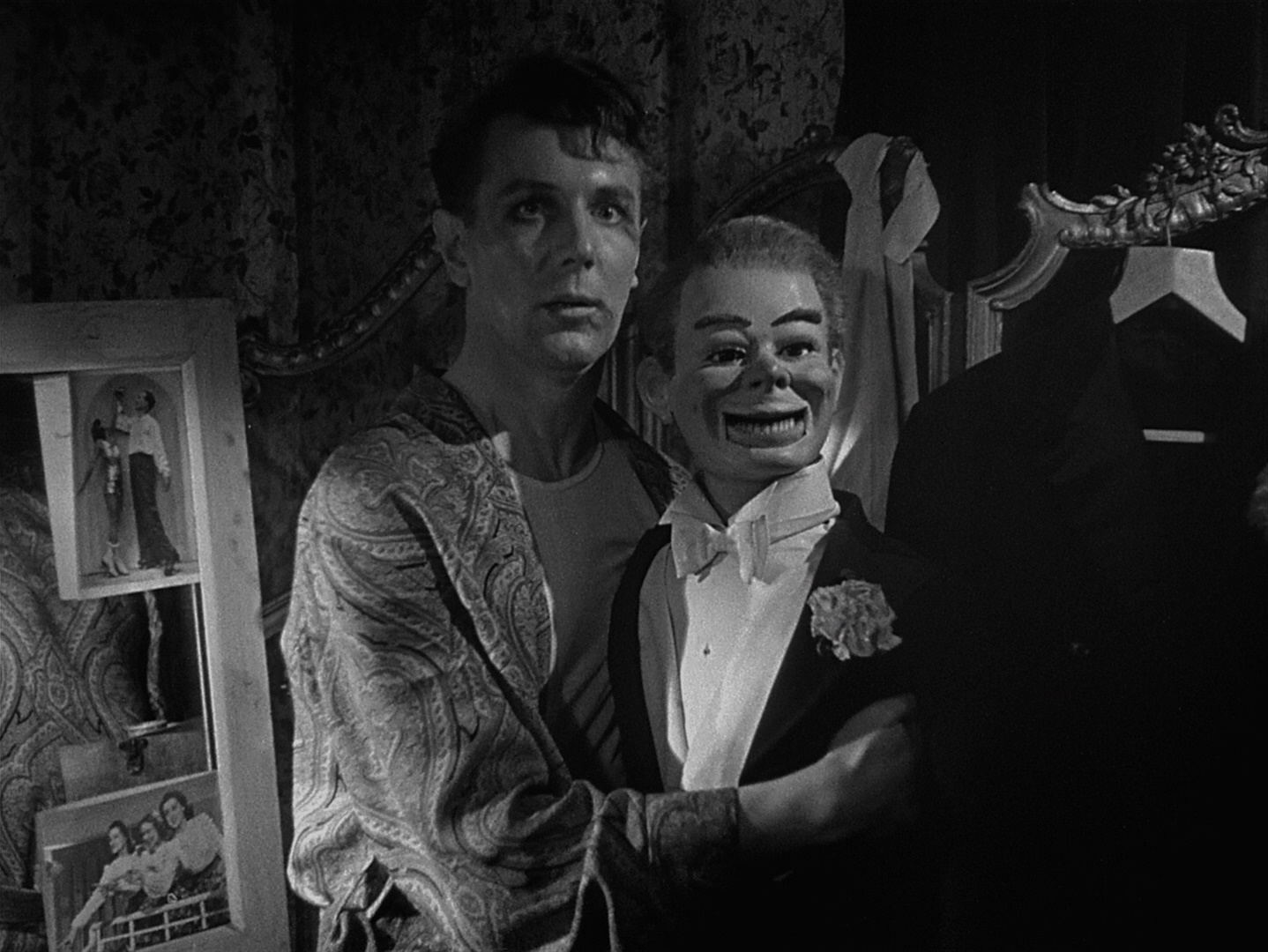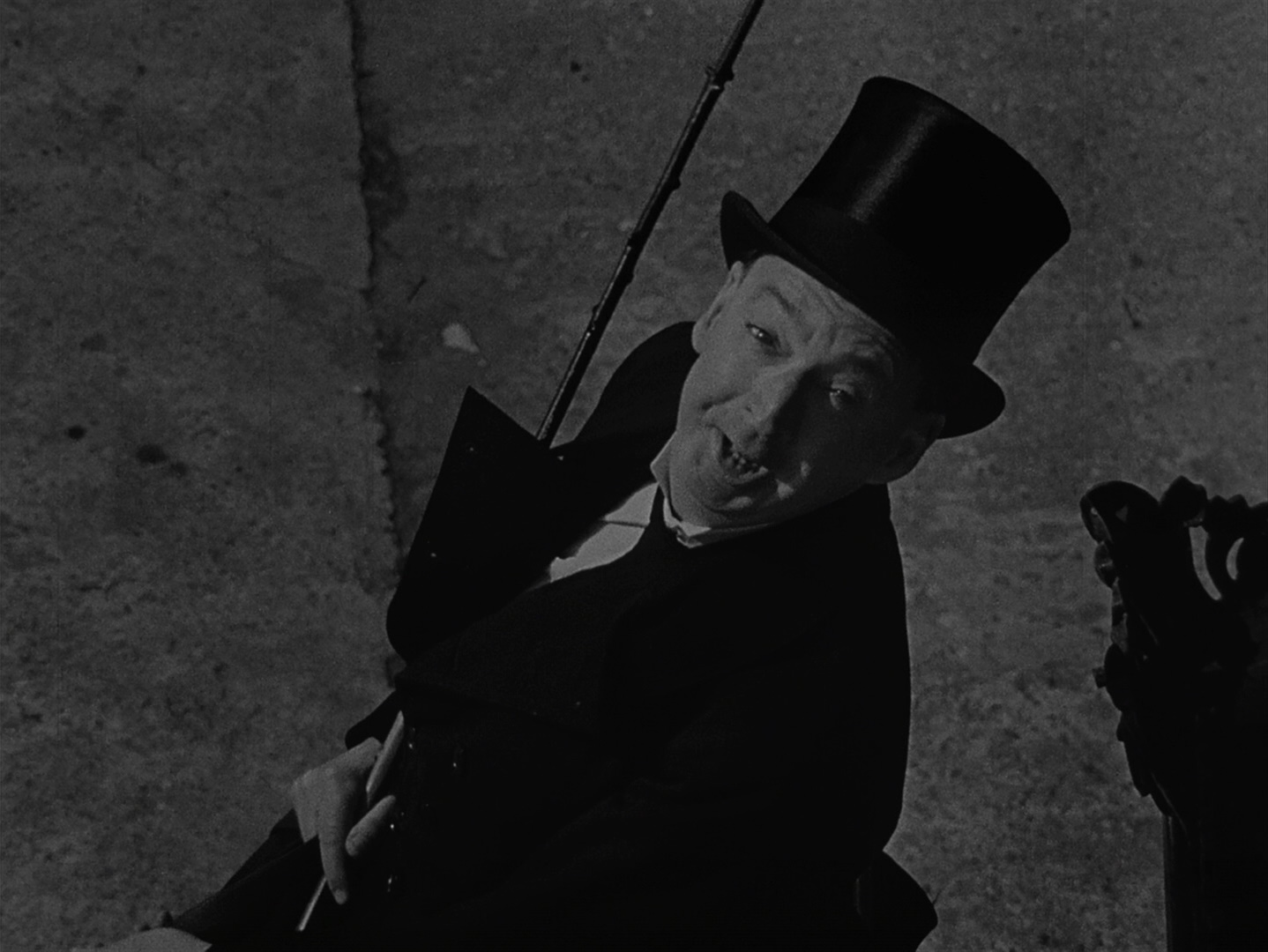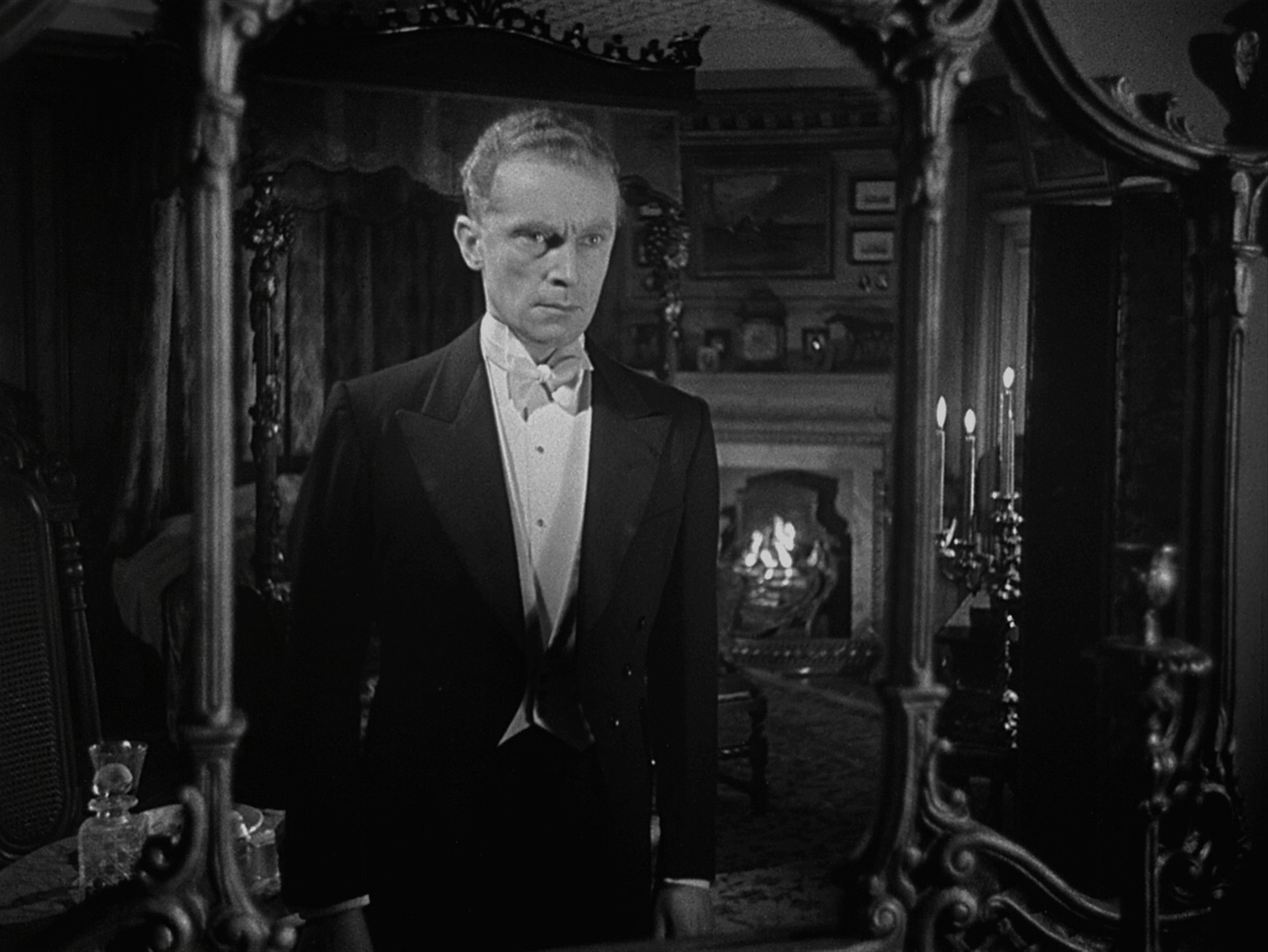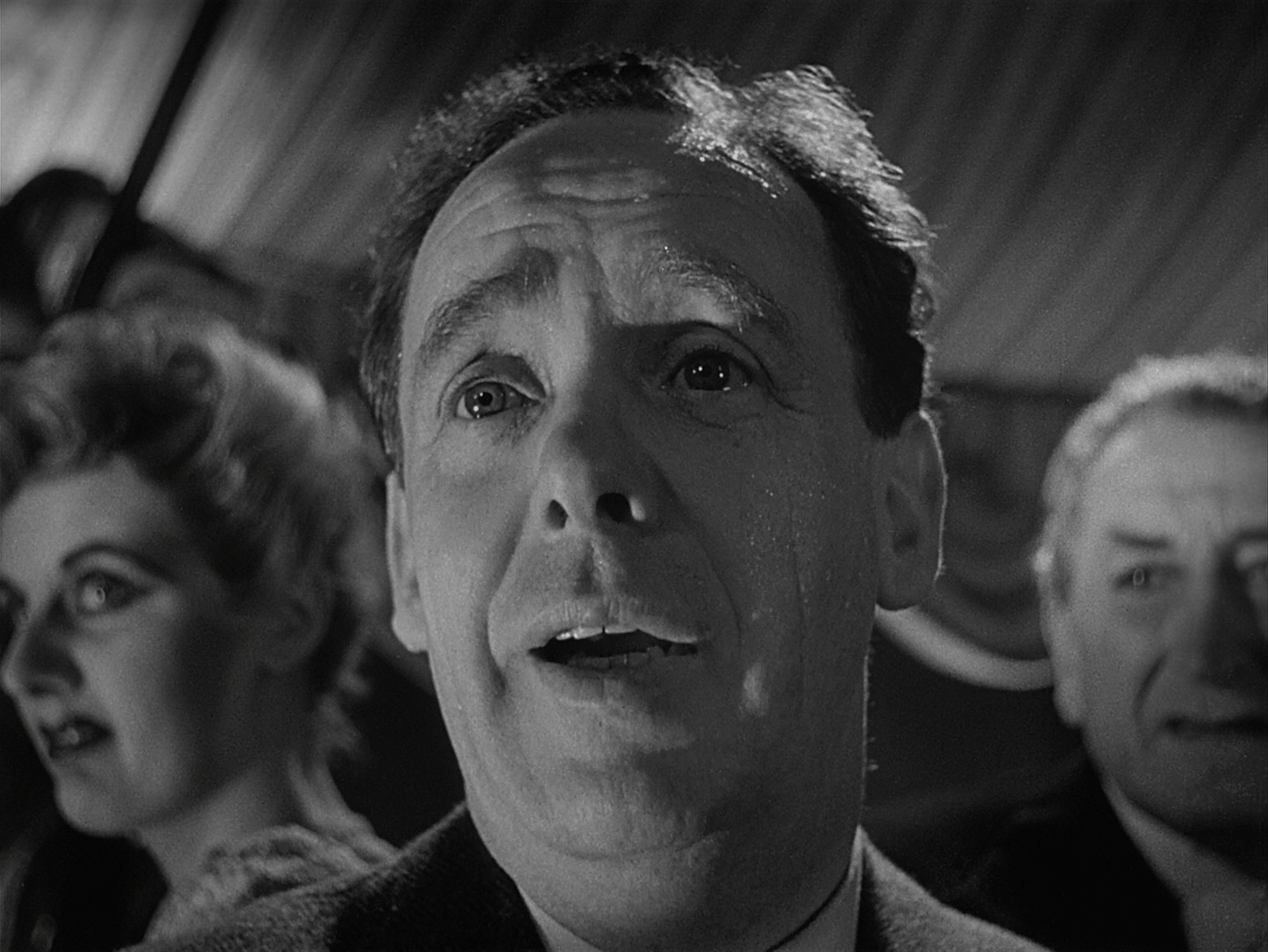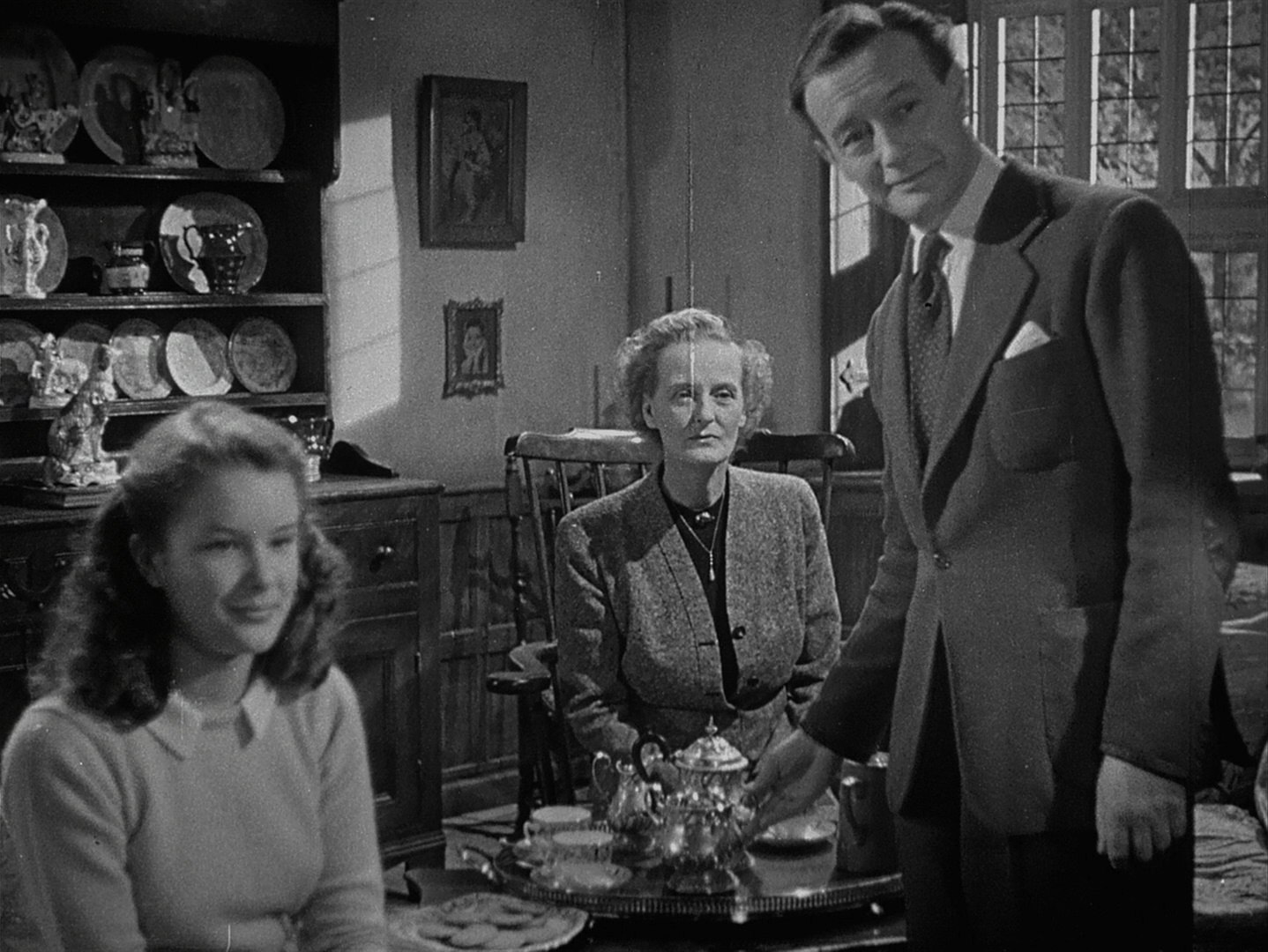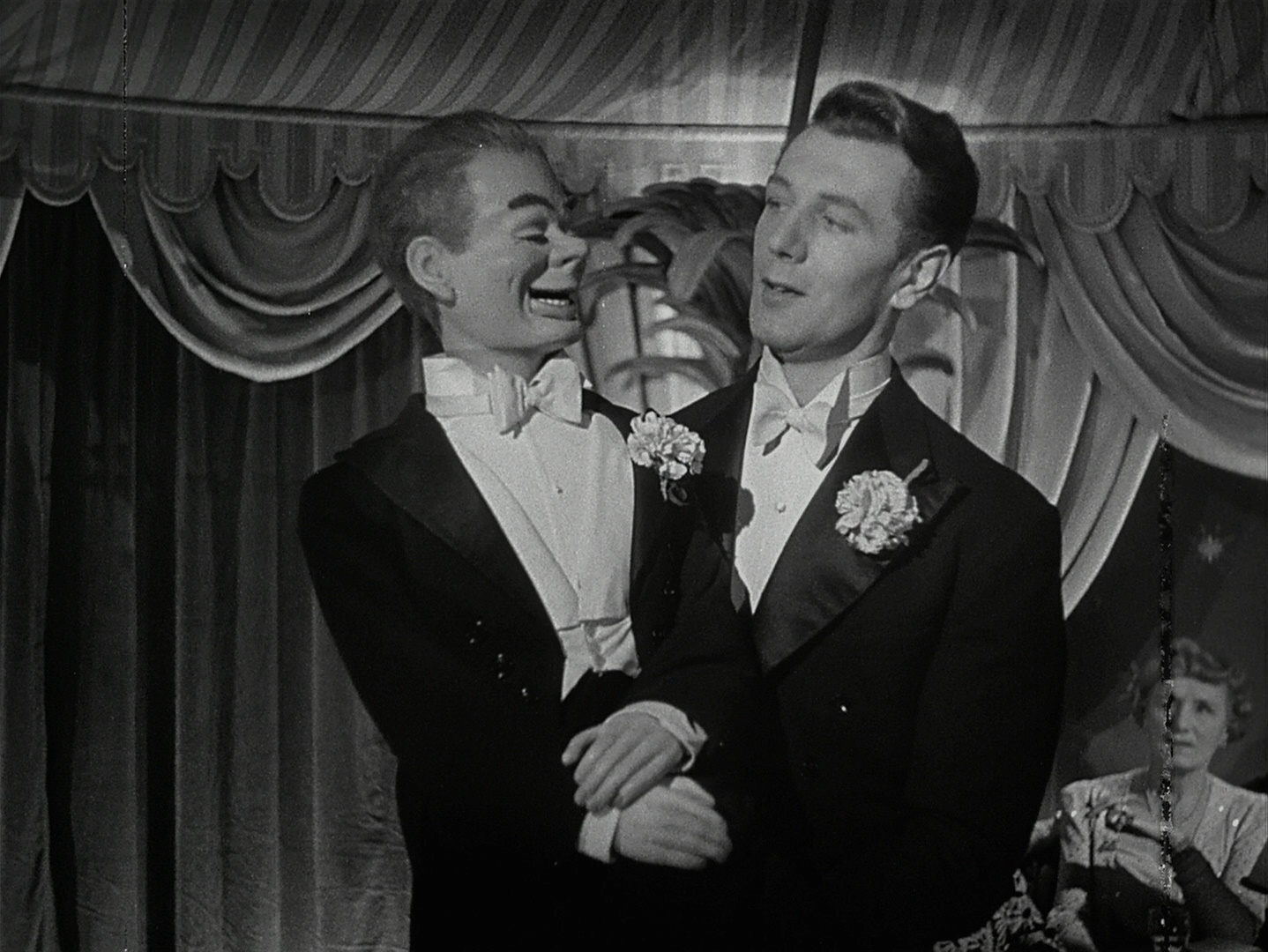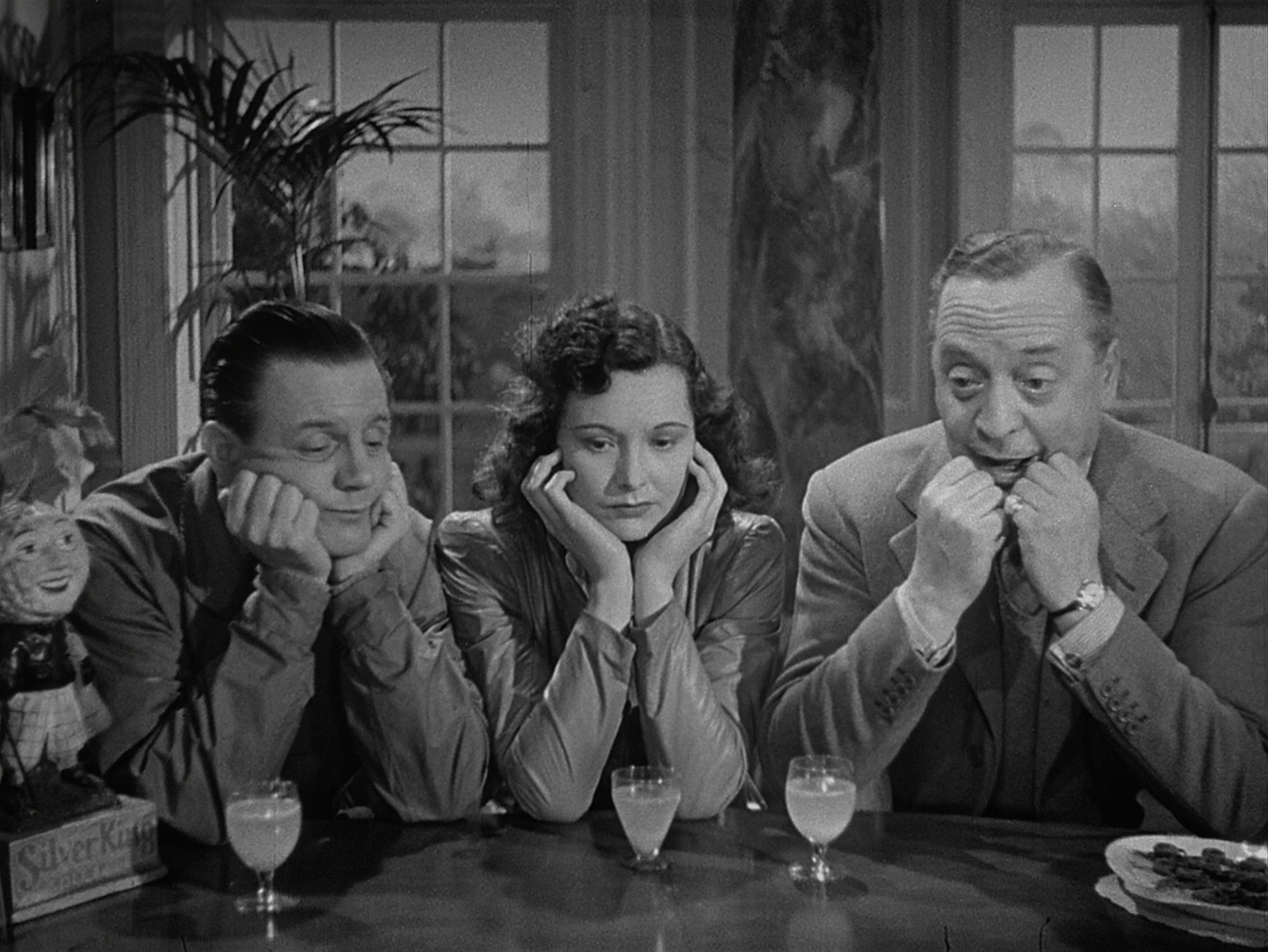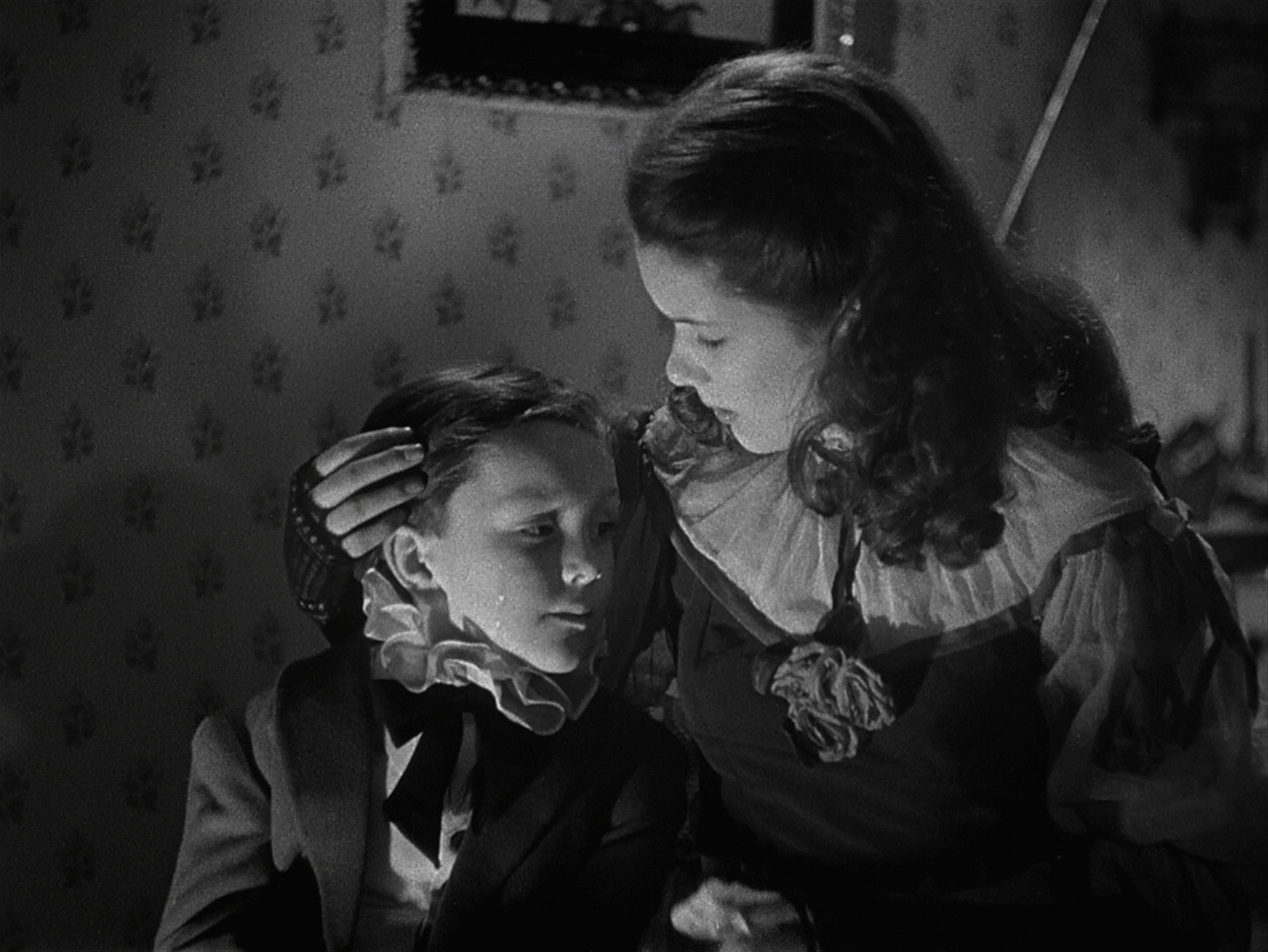| Reviews & Columns |
|
Reviews DVD TV on DVD Blu-ray 4K UHD International DVDs In Theaters Reviews by Studio Video Games Features Collector Series DVDs Easter Egg Database Interviews DVD Talk Radio Feature Articles Columns Anime Talk DVD Savant Horror DVDs The M.O.D. Squad Art House HD Talk Silent DVD
|
DVD Talk Forum |
|
|
| Resources |
|
DVD Price Search Customer Service #'s RCE Info Links |
|
Columns
|
|
|
Dead of Night
Kl Studio Classics // Unrated // July 9, 2019
List Price: $29.95 [Buy now and save at Amazon]
None of the guests at this stately country home have ever met Walter Craig (Mervyn Johns), and yet he's spent every night with them for months on end. As he soon informs them, they've all been fixtures in the recurring nightmare that's long been tormenting him. And while names and other similarly personal details elude Walter, he's able to predict certain key moments throughout the day's events that no one could possibly have foreseen – making his premonitions of something truly evil that awaits all the more unnerving. Some of the guests – chief among them psychiatrist Dr. van Straaten (Frederick Valk) – are skeptical, seeking out a more grounded explanation for Walter's plight. Others believe him more than they'd perhaps like to admit. Regardless, they all have stories to tell about their brushes with the supernatural, or at least something close enough to it. And yet the time that passes with each of their stories brings Walter that much closer to the nightmare he dreads so...
By no means did Ealing Studios invent the horror anthology, but in 1945, they arguably perfected it. Dead of Night established the template that much of Amicus' output, Creepshow, and most any other genre anthology you could name would follow. Several episodes of The Twilight Zone owe a debt to the film, or, at least, the stories that spawned it. Most every creepy motion picture or television episode revolving around a ventriloquist's dummy is either inspired by or outright stealing from Dead of Night's most enduring segment. Nearly seventy five years have passed since the anthology first stormed into British theaters, and its impact remains profound to this day.
Kino Lorber has brought to Blu-ray the original British cut of Dead of Night, restoring two segments ill-advisedly excised from its initial American release. Craig's anguished nightmare frames these five tales of terror, and, admittedly, its opening segments are the least remarkable of the lot.
The first of the partygoers' stories is centered around a pair of drivers: one recently injured behind the wheel of a race car (Anthony Baird) and the other driving a hearse in the wee hours. The hearse driver's nefarious cackle and catchphrase – "room for one more inside, sir!" – serve as a harbinger of death. It's the shortest of the five segments, memorable only for the brief appearances of Miles Malleson as the hearse driver and its spectacular bus crash.
The setting then shifts to a Christmas party, in which we witness a teenager's first blush of romance during a game of hide-and-seek. The estate's labyrinthine upper levels have more to discover than the backdrop for an innocent first kiss. Sally (The Admirable Crichton's Sally Ann Howes) can't claim to be familiar with the grisly tale of Constance Kent, but she soon becomes well-acquainted with its ghostly aftermath. It's effective but perhaps too understated and brief, aiming more towards a mild, spooky chill rather than mortal terror. Not that its excision is indicative of its quality, but this is one of the two segments gutted from the American theatrical release.
Dead of Night is uniformly successful from this point on, beginning with "The Haunted Mirror". In the weeks leading up to their wedding and the renovation of their home-to-be, Joan (Googie Withers) gifts her fiancé (Ralph Michael) an antique mirror. Hugh does, of course, see his reflection whenever he peers into the mirror, but the room around him is one he's never before seen. Utterly consumed by these visions, Hugh no longer finds himself looking at the mirror but is instead drawn towards its unfamiliar, reflected world...becomes transformed by it.
As dark and foreboding as so much of Dead of Night is, its fourth story shifts gears into something far more smirking and playful. George Parratt and Larry Potter (Basil Radford and Naunton Wayne) share two great passions in life: golf and Mary Lee (Peggy Bryan). And as for which of them will wed this comely young woman, the decision inevitably comes down to a round of golf. Whoever wins these eighteen holes will be awarded Mary Lee's hand in marriage. Whoever loses...well, he's to vanish from their lives altogether. But when one of them cheats to secure the win, the other's restless spirit is determined to wreck both his handicap and his love life. This segment – the other to be carved from Dead of Night's American release – is generally reviled, much as Creepshow's "The Lonesome Death of Jordy Verrill" so often is. Honestly, I love it. Of course, this Hitchcock fanatic couldn't get enough of Radford and Wayne in The Lady Vanishes and the echo still reverberating in Carol Reed's Night Train to Munich. It's a thrill to see the two of them teamed here again, even if they're ::cough:: different characters, or at least technically different enough to keep the lawyers at bay. This unapologetically silly and sexually suggestive segment lands all the laughs it's aiming for, with a supernatural underpinning that ensures it's still relevant enough to warrant its hallowed place in Dead of Night.
The last of Dead of Night's segments is beyond any measure its most iconic. As far as their doting audiences are aware, the combative relationship between ventriloquist Maxwell Frere (Michael Redgrave) and his dummy Hugo Fitch is all part of their schtick. Those in the crowd are generally charmed by that bickering, but it at times seems as if Frere isn't in charge of Hugo at all. The dummy awkwardly refuses to perform a musical number that's part and parcel of their act, and he even makes very vocal overtures to a competing ventriloquist in the audience that he'd like to trade up. Which one is the puppet, and who is truly his master? This is far and away the standout segment of Dead of Night, preying on the inherent creepiness of a ventriloquist's dummy – something never really capitalized on in horror cinema prior to this – and benefitting immeasurably from Redgrave's emotionally ravaged performance. It's difficult to imagine much of anyone else capturing how damaged and drained Frere is from untold years of trying to rein in Hugo.
Nearly as impressive is the conclusion of Dead of Night's framing story. In so many horror anthologies, these devices are meant to provide little more than loose connective tissue. Here, we aren't simply treated to the end of Walter's storyline that's been gradually unspooling throughout the film; elements from each individual segment are incorporated as well, infusing the resulting frenzied nightmare with that much more manic energy. More than just an ending, the startling, shocking finalé is a veritable explosion, embracing horror with a more malefic glee than any of the episodes preceding it.
Dead of Night is a seminal and wildly influential horror anthology, yes, but it's remarkable for far more than defining the template that countless others would adopt in the decades to come. And as imitated and outright copied as the film has so often been in the more than seven decades since its original release, its impact and effectiveness have dulled little. Dead of Night is such an extraordinary film. Perhaps if more care had been taken of it over these great many years, the film would boast an equally exceptional presentation on Blu-ray. Disappointingly, a different path was trodden. This review will delve more into that momentarily, but despite the video and audio not hitting the marks deserving of a landmark film such as Dead of Night, this is too important a release to come anything less than Recommended.
Video
I can't begin to fathom how staggering a sum would be required to properly restore Dead of Night, but the budget would doubtless be worlds removed from anything a Blu-ray release could ever hope to recoup. Hopefully the funds will be found someday to lavish this seminal horror anthology with the gorgeous presentation it so richly deserves. And though that day appears to be quite a ways off on the horizon, what Kino Lorber has delivered with Dead of Night is, perhaps, good enough to tide us over until then.
Whereas StudioCanal's Blu-ray release on the other side of the pond was sourced from a 2K scan, Kino Lorber's features a new 4K remaster. The copy on the flipside of the case doesn't specify the exact source, but it's clearly not the original camera negative, which, as far as I know, remains lost. Presumably this remaster is based on the internegative that the BFI National Archive scanned for StudioCanal's high-def release. As it's a couple generations removed from the OCN, film grain isn't nearly as finely resolved as I've come to expect from a 4K scan. Dynamic range is adequate. The definition and detail on display are rather lackluster. And while this remaster is a success in some respects – no cue marks, no massive jitter or tearing – significant damage in the source does still remain intact. Enormous scratches appear not just for frames at a time but, at worst, for several minutes straight:
The experience is diminished somewhat by ample speckling as well. This wear and weather cannot be overlooked. And while some degree of aperture correction is understandable, given how soft the remaining elements reportedly are, I can't shake the feeling that Kino Lorber took this perhaps a step too far. Dead of Night isn't egregiously oversharpened, but there is something mildly harsh and digital about its application. Admittedly, this review appears to be somewhat of an outlier, as a quick skimming of other writeups returns almost universal praise. Take my comments for what they're worth – a single point on a graph – and bear the limited film elements available in mind as well.
Dead of Night arrives on a dual-layer Blu-ray disc at an aspect ratio of 1.33:1. I would've expected 1.37:1 instead, but I can't say that I'd have noticed if I hadn't made it a point to measure.
Audio
Presented in 16-bit, monaural DTS-HD Master Audio, Dead of Night's lossless soundtrack doesn't fare much better, I'm afraid. In particular, its dialogue is thin, trebly, and noisy, making for a decidedly unpleasant listen. To be fair, this isn't an issue specific to Kino Lorber Studio Classics' Blu-ray release. The "Remembering Dead of Night" retrospective from StudioCanal's 2014 edition features excerpts from the film that sound much the same way, and I've come across comments indicating that television airings from decades ago were similarly afflicted. I have no doubt that this harsh quality is a limitation of the best remaining elements, though I do think it's worth setting expectations for potential viewers. I've recorded one excerpt from early in the film below, for anyone who's curious:
Also included are a set of English (SDH) subtitles and a commentary track.
Extras
The Final Word
This is a challenging review to write. The importance and influence of Dead of Night cannot be overstated, and this is a film more than deserving of being celebrated with a world-class visual and aural presentation. And, if pristine film elements could've been unearthed, I have no doubt that's precisely what we'd have been treated to here. That, unfortunately, was not in the cards. The original camera negative is lost. The elements that remain are deeply problematic. There is a ceiling as to what can be realistically accomplished with the resources available. In no way am I denigrating the care and effort that went into this release, and I'd certainly rather see the best can we can do with what we have than no Blu-ray at all. I hope for a definitive release of Dead of Night someday soon. Until that time comes, I'm proud to have this edition – imperfect though it is – on my shelf. Recommended.
By no means did Ealing Studios invent the horror anthology, but in 1945, they arguably perfected it. Dead of Night established the template that much of Amicus' output, Creepshow, and most any other genre anthology you could name would follow. Several episodes of The Twilight Zone owe a debt to the film, or, at least, the stories that spawned it. Most every creepy motion picture or television episode revolving around a ventriloquist's dummy is either inspired by or outright stealing from Dead of Night's most enduring segment. Nearly seventy five years have passed since the anthology first stormed into British theaters, and its impact remains profound to this day.
Kino Lorber has brought to Blu-ray the original British cut of Dead of Night, restoring two segments ill-advisedly excised from its initial American release. Craig's anguished nightmare frames these five tales of terror, and, admittedly, its opening segments are the least remarkable of the lot.
The first of the partygoers' stories is centered around a pair of drivers: one recently injured behind the wheel of a race car (Anthony Baird) and the other driving a hearse in the wee hours. The hearse driver's nefarious cackle and catchphrase – "room for one more inside, sir!" – serve as a harbinger of death. It's the shortest of the five segments, memorable only for the brief appearances of Miles Malleson as the hearse driver and its spectacular bus crash.
The setting then shifts to a Christmas party, in which we witness a teenager's first blush of romance during a game of hide-and-seek. The estate's labyrinthine upper levels have more to discover than the backdrop for an innocent first kiss. Sally (The Admirable Crichton's Sally Ann Howes) can't claim to be familiar with the grisly tale of Constance Kent, but she soon becomes well-acquainted with its ghostly aftermath. It's effective but perhaps too understated and brief, aiming more towards a mild, spooky chill rather than mortal terror. Not that its excision is indicative of its quality, but this is one of the two segments gutted from the American theatrical release.
Dead of Night is uniformly successful from this point on, beginning with "The Haunted Mirror". In the weeks leading up to their wedding and the renovation of their home-to-be, Joan (Googie Withers) gifts her fiancé (Ralph Michael) an antique mirror. Hugh does, of course, see his reflection whenever he peers into the mirror, but the room around him is one he's never before seen. Utterly consumed by these visions, Hugh no longer finds himself looking at the mirror but is instead drawn towards its unfamiliar, reflected world...becomes transformed by it.
As dark and foreboding as so much of Dead of Night is, its fourth story shifts gears into something far more smirking and playful. George Parratt and Larry Potter (Basil Radford and Naunton Wayne) share two great passions in life: golf and Mary Lee (Peggy Bryan). And as for which of them will wed this comely young woman, the decision inevitably comes down to a round of golf. Whoever wins these eighteen holes will be awarded Mary Lee's hand in marriage. Whoever loses...well, he's to vanish from their lives altogether. But when one of them cheats to secure the win, the other's restless spirit is determined to wreck both his handicap and his love life. This segment – the other to be carved from Dead of Night's American release – is generally reviled, much as Creepshow's "The Lonesome Death of Jordy Verrill" so often is. Honestly, I love it. Of course, this Hitchcock fanatic couldn't get enough of Radford and Wayne in The Lady Vanishes and the echo still reverberating in Carol Reed's Night Train to Munich. It's a thrill to see the two of them teamed here again, even if they're ::cough:: different characters, or at least technically different enough to keep the lawyers at bay. This unapologetically silly and sexually suggestive segment lands all the laughs it's aiming for, with a supernatural underpinning that ensures it's still relevant enough to warrant its hallowed place in Dead of Night.
The last of Dead of Night's segments is beyond any measure its most iconic. As far as their doting audiences are aware, the combative relationship between ventriloquist Maxwell Frere (Michael Redgrave) and his dummy Hugo Fitch is all part of their schtick. Those in the crowd are generally charmed by that bickering, but it at times seems as if Frere isn't in charge of Hugo at all. The dummy awkwardly refuses to perform a musical number that's part and parcel of their act, and he even makes very vocal overtures to a competing ventriloquist in the audience that he'd like to trade up. Which one is the puppet, and who is truly his master? This is far and away the standout segment of Dead of Night, preying on the inherent creepiness of a ventriloquist's dummy – something never really capitalized on in horror cinema prior to this – and benefitting immeasurably from Redgrave's emotionally ravaged performance. It's difficult to imagine much of anyone else capturing how damaged and drained Frere is from untold years of trying to rein in Hugo.
Nearly as impressive is the conclusion of Dead of Night's framing story. In so many horror anthologies, these devices are meant to provide little more than loose connective tissue. Here, we aren't simply treated to the end of Walter's storyline that's been gradually unspooling throughout the film; elements from each individual segment are incorporated as well, infusing the resulting frenzied nightmare with that much more manic energy. More than just an ending, the startling, shocking finalé is a veritable explosion, embracing horror with a more malefic glee than any of the episodes preceding it.
Dead of Night is a seminal and wildly influential horror anthology, yes, but it's remarkable for far more than defining the template that countless others would adopt in the decades to come. And as imitated and outright copied as the film has so often been in the more than seven decades since its original release, its impact and effectiveness have dulled little. Dead of Night is such an extraordinary film. Perhaps if more care had been taken of it over these great many years, the film would boast an equally exceptional presentation on Blu-ray. Disappointingly, a different path was trodden. This review will delve more into that momentarily, but despite the video and audio not hitting the marks deserving of a landmark film such as Dead of Night, this is too important a release to come anything less than Recommended.
Video
I can't begin to fathom how staggering a sum would be required to properly restore Dead of Night, but the budget would doubtless be worlds removed from anything a Blu-ray release could ever hope to recoup. Hopefully the funds will be found someday to lavish this seminal horror anthology with the gorgeous presentation it so richly deserves. And though that day appears to be quite a ways off on the horizon, what Kino Lorber has delivered with Dead of Night is, perhaps, good enough to tide us over until then.
Whereas StudioCanal's Blu-ray release on the other side of the pond was sourced from a 2K scan, Kino Lorber's features a new 4K remaster. The copy on the flipside of the case doesn't specify the exact source, but it's clearly not the original camera negative, which, as far as I know, remains lost. Presumably this remaster is based on the internegative that the BFI National Archive scanned for StudioCanal's high-def release. As it's a couple generations removed from the OCN, film grain isn't nearly as finely resolved as I've come to expect from a 4K scan. Dynamic range is adequate. The definition and detail on display are rather lackluster. And while this remaster is a success in some respects – no cue marks, no massive jitter or tearing – significant damage in the source does still remain intact. Enormous scratches appear not just for frames at a time but, at worst, for several minutes straight:
The experience is diminished somewhat by ample speckling as well. This wear and weather cannot be overlooked. And while some degree of aperture correction is understandable, given how soft the remaining elements reportedly are, I can't shake the feeling that Kino Lorber took this perhaps a step too far. Dead of Night isn't egregiously oversharpened, but there is something mildly harsh and digital about its application. Admittedly, this review appears to be somewhat of an outlier, as a quick skimming of other writeups returns almost universal praise. Take my comments for what they're worth – a single point on a graph – and bear the limited film elements available in mind as well.
Dead of Night arrives on a dual-layer Blu-ray disc at an aspect ratio of 1.33:1. I would've expected 1.37:1 instead, but I can't say that I'd have noticed if I hadn't made it a point to measure.
Audio
Presented in 16-bit, monaural DTS-HD Master Audio, Dead of Night's lossless soundtrack doesn't fare much better, I'm afraid. In particular, its dialogue is thin, trebly, and noisy, making for a decidedly unpleasant listen. To be fair, this isn't an issue specific to Kino Lorber Studio Classics' Blu-ray release. The "Remembering Dead of Night" retrospective from StudioCanal's 2014 edition features excerpts from the film that sound much the same way, and I've come across comments indicating that television airings from decades ago were similarly afflicted. I have no doubt that this harsh quality is a limitation of the best remaining elements, though I do think it's worth setting expectations for potential viewers. I've recorded one excerpt from early in the film below, for anyone who's curious:
Also included are a set of English (SDH) subtitles and a commentary track.
Extras
- Audio Commentary: Among the many highlights of Tim Lucas' commentary are that the all-too-real Constance Kent inspired not just this anthology's second segment but the character of Sherlock Holmes, a deep dive into the prevalence of evil mirrors throughout the annals of horror cinema, that there was no back-up mirror in that segment should something have gone awry, Michael Redgrave studying ventriloquism for three months (!) to be utterly convincing as Maxwell Frere, and Universal's unconventional marketing tactics on these shores. And given Lucas' encyclopediac intimacy with all things film, he also draws parallels with everything from The Twilight Zone to the work of Mario Bava to Psycho. This is a rewarding listen, as Lucas' commentaries invariably are, and there's surprisingly little overlap with Dead of Night's other conversations with film historians.
- Remembering Dead of Night (76 min.; HD): This feature-length retrospective is oriented around analysis from Keith M. Johnston, Danny Leigh, Kim Newman, Matthew Sweet, Jonathan Romney, Reece Shearsmith, and John Landis. It opens with a primer into Ealing Studios' output, the state of the British ghost story in film during these years, and the elements that make Dead of Night unique, even among its successors and imitators. From there, this retrospective dissects each of the anthology's segments in order. This includes an argument that Joan is the protagonist of "The Haunted Mirror" rather than her tormented husband, how the American release was diminished by its excision of two segments, and why "The Ventriloquist's Dummy" endures as it has. Further examination follows, such as Dead of Night's intertwining of the supernatural and the sexual, the stance it takes on science versus spiritualism, the curious lack of references to the war in a 1945 film, and even its influence on Fred Hoyle's Steady-state theory, alongside commentary on the film's camerawork, set design, and lighting.
The Final Word
This is a challenging review to write. The importance and influence of Dead of Night cannot be overstated, and this is a film more than deserving of being celebrated with a world-class visual and aural presentation. And, if pristine film elements could've been unearthed, I have no doubt that's precisely what we'd have been treated to here. That, unfortunately, was not in the cards. The original camera negative is lost. The elements that remain are deeply problematic. There is a ceiling as to what can be realistically accomplished with the resources available. In no way am I denigrating the care and effort that went into this release, and I'd certainly rather see the best can we can do with what we have than no Blu-ray at all. I hope for a definitive release of Dead of Night someday soon. Until that time comes, I'm proud to have this edition – imperfect though it is – on my shelf. Recommended.
|
| Popular Reviews |
| Sponsored Links |
|
|
| Sponsored Links |
|
|
| Release List | Reviews | Shop | Newsletter | Forum | DVD Giveaways | Blu-Ray | Advertise |
|
Copyright 2024 DVDTalk.com All Rights Reserved. Legal Info, Privacy Policy, Terms of Use,
Manage Preferences,
Your Privacy Choices | |||||||









